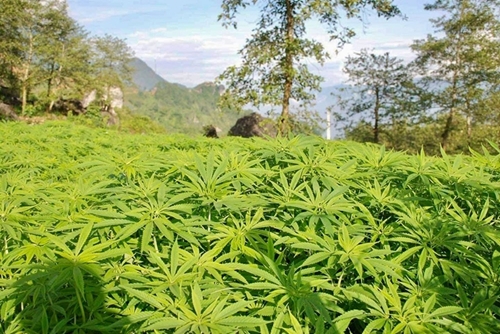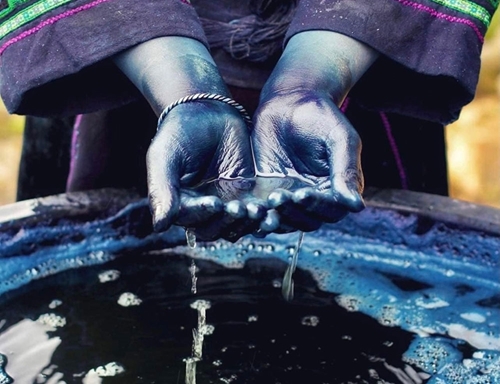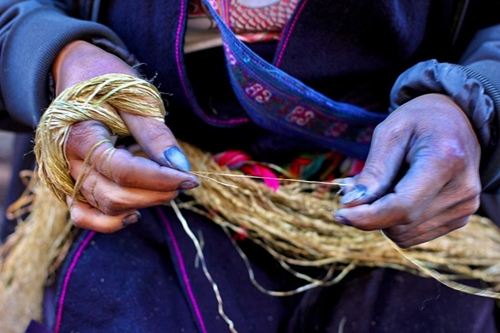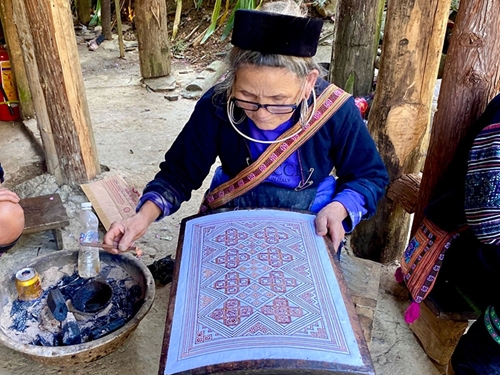    |
 |
|
January is the time to sow flax seeds. The harvest is carried out within about 70 days. |
According to 54-year old Trang Thi Phenh in Lung Xa village, Long Luong commune, Van Ho district, Son La province, when spring comes, local people start sowing flax seeds, which are mixed well with rotted manure, on limestone mountains. The plants will be harvested about 70 days after they are sowed. It is said that the time of harvesting is very important since it affects the quality of the flax fiber.
Linen is a soft and cool fabric. Making a linen cloth requires a lot of efforts and time as well as artisans’ ingenuity, patience, and persistence. To turn flax in to linen, H’mong locals have to go through numerous difficult stages.
After flax plants are harvested, they are dried in the sun. The dried plants’ stems are then broken and separated into the exterior fibers and the interior fibers, which are used to make the linen.
Mrs. Phenh said that in this stage artisans must be careful to make sure that interior fibers are not broken into pieces because they will affect the quality of later products. They are then soaked in cold water for from 10 to 20 minutes before being spun.
For the H’mong people, linen is indispensable to their cultural life and attached to them since they are kids. They do whatever it takes to have at least one linen costume in their wardrobe. That’s why people say that the peaceful and beautiful image of H’mong women weaving demonstrates the prosperity of locals and the community in the Northwestern region.
    |
 |
|
Indigo for dyeing fabrics |
To create bright white flax fibers, H’mong people soak them in boiled water which is sprinkled with the ashes of the bark of a kind of hard wood tree for two days before washing them.
The flax fibers are then spun into thread or yarn. This process requires much effort, techniques, and the harmonious movements of artisans’ body parts, from hands to hips.
Like Mrs. Phenh, 65-year-old Giang Thi Denh became closely attached to needles and flax fibers when she was six years old. The difference in weaving linen fabric between the H’mong ethnic minority group and people in other localities is the way artisans stretching the fabrics and spinning fibers. Local artisans often use their belts to tie and stretch the fabrics and their feet to pull the fibers to wind. These processes require the harmonious coordination between hands, feet, and back to make a beautiful and smooth fabric as desired.
Fabrics are then dyed indigo, which is obtained from a familiar plant in the H’mong people’s gardens. Dying is another important step in making linen since the intensity of the color depends on the number of times the fabrics are dyed. Dipping white cloths in indigo water once will produce light indigo fabrics, which are then dried in the sun.
    |
 |
|
Making a linen cloth requires a lot of efforts and time as well as artisans’ ingenuity, patience, and persistence. |
According to Mrs. Denh, after fabrics are dyed, artisans apply a unique weaving techniques to create colorful patterns on indigo background. To create those patterns, artisans use wax and bronze paint brushes of different sizes to carefully and skillfully draw rectangular, squares, circle, diamond, cross shapes on fabrics.
Once this stage is completed, the fabrics are dyed indigo again until no wax area turn black. After that, artisans will melt wax to release bluish white patterns drawn earlier. This is a simple, but creative and unique tip of the H’mong people in making linen.
Another process demonstrating the talent of the H’mong artisans is creating patterns on fabrics. From drawn shape patterns, artisans with their talent and creativity will turn the fabrics into beautiful and colorful ones by adding more embroidery patterns. For the H’mong people, circles and crosses are the two main shapes because they believe that circles representing the tiger's claws symbolize the strength of the community, while cross-shaped patterns demonstrate their hard work.
Apart from making patterns, weavers join fabrics together to make costumes more colorful, special, and subtle.
    |
 |
|
Mrs. Giang Thi Denh drawing patterns on a white linen fabric |
It is clear that flax growing and weaving is a clear proof of diligence, creativity, and spirit of overcoming all difficult and harsh conditions for a better future of the H’mong ethnic minority people. The colorful linen fabrics made by local women also help visitors understand the precious traditional culture that the H’mong people in the Northwestern region have striven to preserve and develop through ups-and-downs in history.
Translated by Tran Hoai